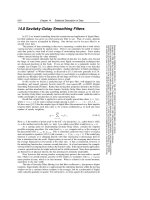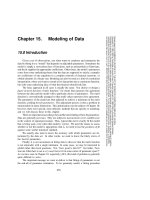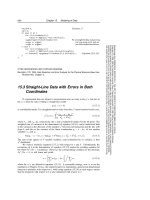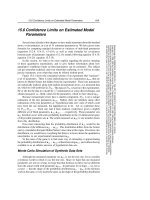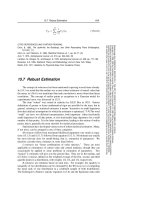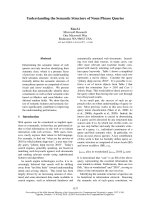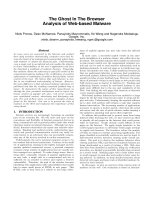THE FRACTAL STRUCTURE OF DATA REFERENCE- P16 pptx
Bạn đang xem bản rút gọn của tài liệu. Xem và tải ngay bản đầy đủ của tài liệu tại đây (147.34 KB, 5 trang )
62
THE FRACTAL STRUCTURE OF DATA REFERENCE
1. THE CASE FOR LRU
In this section, our objective is to determine the best scheme for managing
memory, given that the underlying data conforms to the multiple
-
workload
hierarchical reuse model. For the present, we focus on the special case θ
1
=
θ
1
= = θ
n
. In this special case, we shall discover that the scheme we are
looking for is, in fact, the
LRU algorithm.
As in Chapter 4, we consider the optimal use of memory to be the one that
minimizes the total delay due to cache misses. We shall assume that a fixed
delay D
1
= D
2
= . . . = D
n
= D > 0, measured in seconds, is associated with
each cache miss. Also, we shall assume that all workloads share a common
stage size z
1
= z
2
= . . . = z
n
= z > 0. We continue to assume, as in the
remainder of the book, that the parameter θ lies in the range 0 < θ < 1. Finally,
we shall assume that all workloads are non
-
trivial (that is, a non
-
zero I/O rate
is associated with every workload). The final assumption is made without loss
of generality, since clearly there is no need to allocate any cache memory to a
workload for which no requests must be serviced.
We begin by observing that for any individual workload, data items have
corresponding probabilities of being requested that are in descending order of
the time since the previous request, due to (1.3). Therefore, for any individual
workload, the effect of managing that workload’s memory via the
LRU mech
-
anism is to place into cache memory exactly those data items which have the
highest probabilities of being referenced next. This enormously simplifies our
task, since we know how to optimally manage any given amount of memory
assigned for use by workload i. We must still, however, determine the best
trade
-
off of memory among the n workloads.
The optimal allocation of memory must be the one for which the marginal
benefit (reduction of delays), per unit of added cache memory, is the same for
all workloads. Otherwise, we could improve performance by taking memory
away from the workload with the smallest marginal benefit and giving it to the
workload with the largest benefit. At least in concept, it is not difficult to pro
-
duce an allocation of memory with the same marginal benefit for all workloads,
since, by the formula obtained in the immediately following paragraph, the
marginal benefit for each workload is a strict monotonic decreasing function of
its memory. We need only decide on some specific marginal benefit, and add
(subtract) memory to (from) each workload until the marginal benefit reaches
the adopted level. This same conceptual experiment also shows that there is
a unique optimal allocation of memory corresponding to any given marginal
benefit, and, by the same token, a unique optimal allocation corresponding to
any given total amount of memory.
The next step, then, is to evaluate the marginal benefit of adding memory for
use by any individual workload i. Using (1.23), we can write the delays due to
Memory Management in an LRU Cache
63
misses, in units of seconds of delay per second of clock time, as:
(5.1)
Therefore, the marginal reduction of delays with added memory is:
by (1.21). Thus, we may conclude, by (1.12), that the marginal benefit of added
memory is:
(5.2)
But, for the purpose of the present discussion, we are assuming that all
workloads share the same, common workload parameters θ, D, and z. To
achieve optimal allocation, then, we must cause all of the workloads to share,
as well, a common value τ
1
= τ
2
= = τ
n
= τ for the single
-
reference
residency time. Only in this way can we have θ
1
D
1
/z
1
τ
1
= θ
2
D
2
/z
2
τ
2
=
As we have seen, exactly this behavior is accomplished by applying global
LRU management. A global LRU policy enforces LRU management of each
individual workload's memory, while also causing all of the workloads to
share the same, common single
-
reference residency time. For the special case
θ
1
= θ
2
= = θ
n
,
LRU management of cache memory is therefore optimal.
1.1 IMPACT OF MEMORY PARTITIONING
In the assumptions stated at the beginning of the section, we excluded those
cases, such as a complete lack of
I/O, in which any allocation of memory is as
good as any other. Thus, we can also state the conclusion just presented as
follows: a memory partitioned by workload can perform as well as the same
memory managed globally, only if the sizes of the partitions match with the
allocations produced via global
LRU management.
Our ability to gain insight into the impact of subdivided cache memory
is of some practical importance, since capacity planners must often examine
= θ
n
D
n
/z
n
τ
n
= θD/zτ.
64
the possibility of dividing a workload among multiple storage subsystems. In
many cases there are compelling reasons for dividing a workload; for example,
multiple subsystems may be needed to meet the total demand for storage,
cache, and/or
I/O throughput. But we have just seen that if such a strategy
is implemented with no increase in total cache memory, compared with that
provided with a single subsystem, then it may, as a side effect, cause some
increase in the
I/O delays due to cache misses. By extending the analysis
developed so far, it is possible to develop a simple estimate of this impact, at
least in the interesting special case in which a single workload is partitioned
into n
p
equal cache memories, and the I/O rate does not vary too much between
partitions.
We begin by using (5.1) as a starting point. However, we now specialize our
previous notation. A single workload, with locality characteristics described
by the parameters b, θ,z,and D, is divided into n
p
equal cache memories,
each of size s
p
= s/n
p
. We shall assume that each partition i =1,2,. . .,n
p
has a corresponding I/O rate r
i
(that is, different partitions of the workload
are assumed to vary only in their
I/O rates, but not in their cache locality
characteristics). These changes in notation result in the following, specialized
version of (5.1):
THE FRACTAL STRUCTURE OF DATA REFERENCE
(5.3)
Our game plan will be to compare the total delays implied by (5.3) with
the delays occurring in a global cache with the same total amount of memory
s = n
p
s
p
. For the global cache, with I/O rate r, the miss ratio m is given by
(1.23):
where r
-
= r/n
p
is the average I/O rate per partition. Therefore, we can express
the corresponding total delays due to to misses, for the global cache, as
(5.4)
Turning again to the individual partitions, it is helpful to use the average
partition
I/O rate r
-
as a point of reference. Thus, we normalize the individual
partition
I/O rates relative to :
(5.5)
Memory Management in an LRU Cache
65
where
Our next step is to manipulate the right side of (5.5) by applying a binomial
expansion. This technique places limits on the variations in partition
I/O rates
that we are able to take into account. At a minimum we must have |δ
i
| < 1
for i = 1, 2, . . . , n
p
in order for the binomial expansion to be valid; for
mathematical convenience, we shall also assume that the inequality is a strong
one.
Provided, then, that the partition
I/O rates do not vary by too much from their
average value, we may apply the binomial theorem to obtain
Using this expression to substitute into (5.3), the
I/O delays due to misses in
partition i are therefore given by:
where we have used (5.4) to obtain the second expression.
Taking the sum of these individual partition delays, we obtain a total of:
But it is easily shown from the definition of the quantities δ
i
that
and
where Var[.] refers to the sample variance across partitions; that is,
66
Therefore:
THE FRACTAL STRUCTURE OF DATA REFERENCE
Since the term involving the sample variance is always non
-
negative, the
total delay can never be less than Drm (the total delay of the global cache). If
we now let
be the weighted average miss ratio of the partitioned cache, weighted by
I/O
rate, then we can restate our conclusion in terms of the average delay per I/O:
(5.6)
where the relative “penalty” due to partitioning, is given by:
In applying (5.6), it should be noted that the value of is not affected if all
the
I/O rates are scaled using a multiplicative constant. Thus, we may choose
to express the partition
I/O rates as events per second, as fractions of the total
load, or even as fractions of the largest load among the n
p
partitions.
A “rule of thumb” that is sometimes suggested is that, on average, two
storage subsystems tend to divide the total
I/O rate that they share in a ratio of
60 percent on one controller, 40 percent on the other. This guestimate provides
an interesting illustration of (5.6).
Suppose that both subsystems, in the rule of thumb, have the same amount
of cache memory and the same workload characteristics. Let us apply (5.6)
to assess the potential improvement in cache performance that might come
from consolidating them into a single subsystem with double the amount of
cache memory possessed by either separately. Since we do not know the actual
I/O rates, and recalling that we may work in terms of fractions of the total
load, we proceed by setting r
1
and r
2
to values of .4 and .6 respectively. The
sample variance of these two quantities is (.12 + .1
2
)/(2–1) = .02. Assuming
θ = 0.25, we thus obtain ≈
1
/2 x
1
/2 x (.25/.75
2
) x (.02/.5
2
) ≈ .009.
Based upon the calculation just presented, we conclude that the improvement
in cache performance from consolidating the two controllers would be very
slight (the delay per
I/O due to cache misses would be reduced by less than one
percent). From a practical standpoint, this means that the decision on whether
to pursue consolidation should be based on other considerations, not dealt with
in the present analysis. Such considerations would include, for example, the
cost of the combined controller, and its ability to deliver the needed storage and
I/O throughput.
